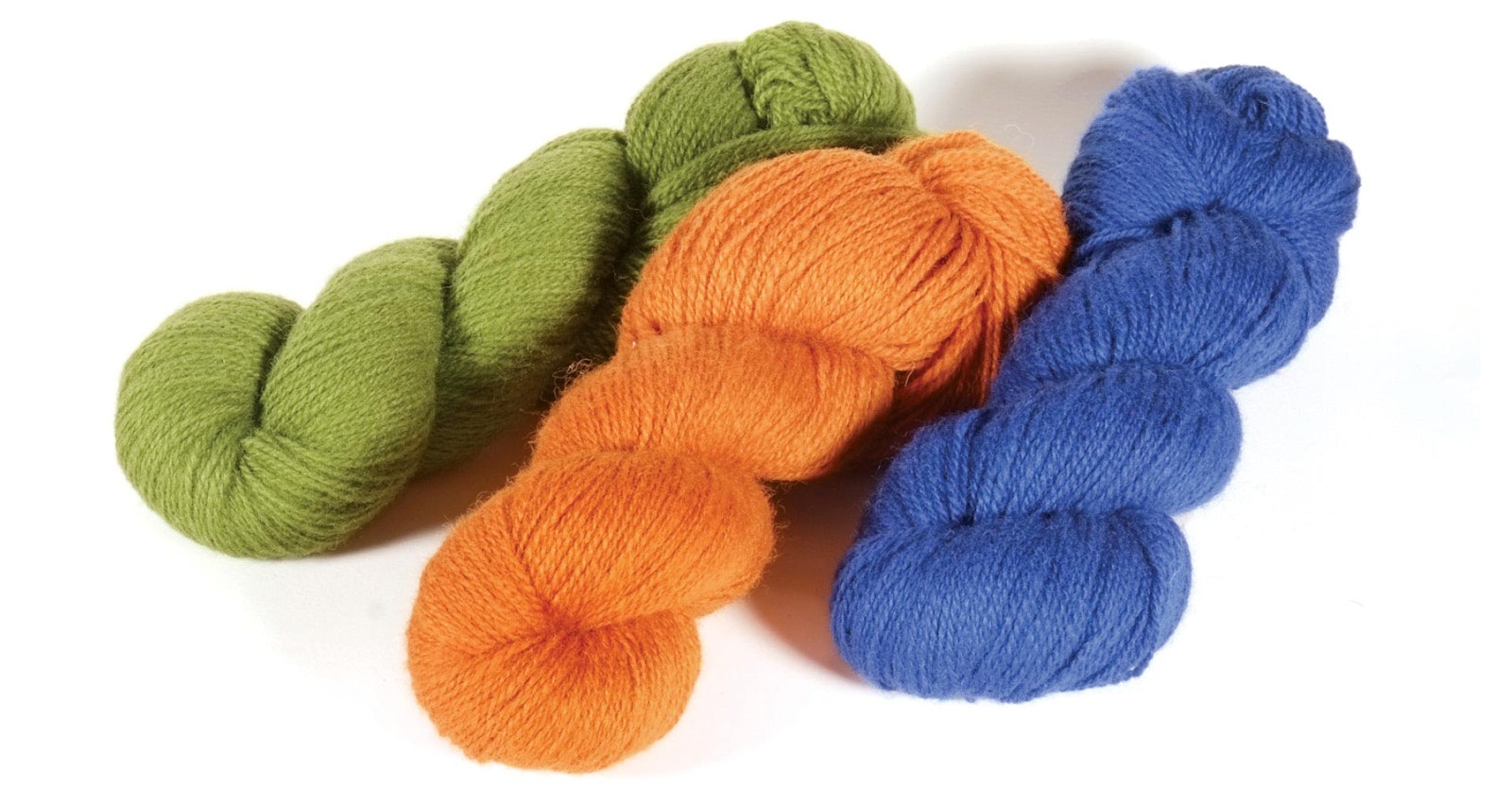Swedes have a long history of sorting their fleeces, knowing exactly which types of wool are best for different purposes, and spinning them according to each purpose. For this Yarn Lab, I sampled with two lesser-known Swedish yarns carried by Vävstuga— Åsborya and Brage—to show how best to use them in weaving.
THE YARN: Åsborya
(595 yd/lb, 131 yd/100 g skein, 100% wool), Borgs via Vävstuga, 61 colorways.
This 2.5/2 wool is the authentic yarn used for rya and flossa pile rugs. It is a heavy-duty two-ply wool yarn with a fair amount of twist and a beautiful sheen. The traditional warp yarn used with Åsborya is a high-twist 8/3 linen rug yarn that creates a firm and durable base for the resulting rug. I have also experimented using the Åsborya yarn as warp for different fabrics as well as for beautiful knitted mittens. Note: All samples were woven on a traditional Swedish loom using metric reeds. As such, all setts are given in ends/picks per centimeter or 10 centimeters, with approximate calculations for ends per inch (epi) and picks per inch (ppi) in parentheses.

SAMPLE 1: Rya
Sample Yarns: Warp, 8/3 linen rug warp (unbleached); weft, Åsborya for knots and selvedge (#4039 Garnet, #4036 Sienna, #4031 Terracotta, #4069 Eggplant, #4047 Black Walnut, #4000 Unbleached); ground weft, Mattgarn (#5013 Natural Brown).
Setts: 30 ends per 10 cm; 10 knot rows per cm; 6 doubled-tabby picks per cm (8 epi; 25 knot rows per inch; doubled tabby, 15 ppi).
The luster of this yarn shines beautifully when used as knotted pile, its intended use. The stiffness of the fibers and the brilliance of the colors give a depth of quality that I have not seen matched by any other yarn that I have used for this purpose.

SAMPLE 2: Damask twill
Sample Yarns: Warp and weft, Åsborya (#4013 Citrine, #4069 Eggplant).
Setts: 25 ends per 10 cm; 25 picks per 10 cm (6 epi; 6 ppi).
Even though this yarn is intended for knotted pile, I could not resist the temptation to try it in a balanced 3/1 twill on the drawloom. This easy-to-work-with yarn makes a dense and durable fabric, bringing forth the natural shine and luster of the tightly spun wool yarn. It lies beautifully flat and is wrinkle-free after washing.
THE YARN: Brage
(1,687 yd/lb, 372 yd/100 g skein; 100% wool), Borgs via Vävstuga, 46 colorways.
This 7.5/2 sportweight yarn has endless applications. I usually use it where the yarn will be front and center, such as for weft-faced bands or boundweave or in fabrics with weft pattern floats. Its strength and flexibility make it a good choice for new weavers. It makes excellent dense fabrics for jackets or vests, tapestries, or plain-weave bands.

SAMPLE 3: Skillbragd
Sample Yarns: Warp, 16/2 line linen (unbleached); pattern weft, Brage (#6006 Daffodil, #6040 Pumpkin, #6021 Light Brick, #6022 Burnt Orange, #6756 Sienna, #6042 Mahogany, #6037 Bronze, #6045 Deep Purple, #6633 Silver, #6003 Dark Natural Grey, #6004 Natural Brown); tabby weft, 16/1 line linen (unbleached).
Setts: 110 ends per 10 cm; 60 picks per 10 cm (28 epi; 15 ppi).
I wove this coverlet using Brage as the pattern weft. The result is a supple and heavily patterned durable fabric. Combining Brage with a linen warp and tabby at this sett makes an excellent heavy-ish coverlet weight. The coverlet can also be successfully backed with a sheepskin.

SAMPLE 4: Dukagång
Sample Yarns: Warp, 16/3 line linen (unbleached); pattern weft, Brage (#6099 Black, #6001 Unbleached, #6052 Apple Green, #6759 Goldenrod, #6032 Yale Blue); tabby weft, Möbelåtta (#3821 Brick).
Setts: 45 ends per 10 cm; 52 doubled pattern picks per 10 cm; 208 tabby picks per 10 cm (11 epi; doubled pattern, 13 ppi; tabby, 53 ppi).
Brage wool yarn is an excellent choice for dense weft-faced decorative weaving techniques. It is not so tightly spun as to look stringy, but is squishy and woolly enough to pack together creating the appearance of a smooth, solid surface of color as in the dukagång design.

SAMPLE 5: Bandweaving
Sample Yarns: Ground warp, 16/3 line linen (unbleached); pattern warp, Brage (#6032 Yale Blue); weft, 16/3 line linen (unbleached).
Setts: 20 ends per 10 cm; 48 picks per 10 cm (5 epi; 14 ppi).
This is one of my favorite yarns to weave into dense and durable warp-faced bands. The bands are supple yet stiff enough to hold their own and lie flat after being tied or otherwise abused. Note the clear solid colors in the designs.
FINAL THOUGHTS
I learned to weave using these yarns from many skilled Swedish weavers who generously shared their valuable knowledge with me, and I have dedicated my life and my work at Vävstuga to perpetuating this kind of education for generations to come. While Swedish weaving yarns might seem intimidating to new weavers, I encourage weavers of all levels to try these beautiful, sturdy wool yarns in a variety of projects.

